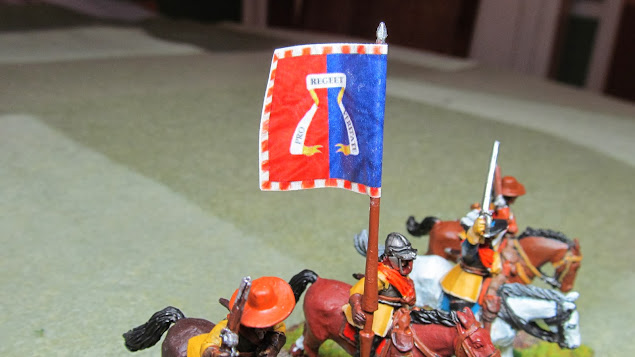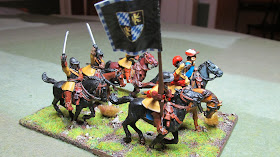I have to give a big shout out the the hobby store site Architects of War. Wow . . . talk about great service.
I ordered the miniatures Sunday night online, free shipping in the USA for orders over $50 and bam - they were here Wednesday!
Most young boys (and some adventurous girls) play with Toy Soldiers; some never stop! I'm proud to say that I am one that never has stopped. Toy Soldiers, painting the figures, history and miniature wargaming is what this site is all about. May the God who gives encouragement give you the same attitude of mind toward each other that Christ Jesus had, so that with one mind and one voice you may glorify the God and Father of our Lord Jesus Christ.
As an Amazon Associate I earn from qualifying purchases
▼
Friday, January 17, 2014
Monday, January 13, 2014
Taunting Highland Clansman
An exclusive bonus figure comes with the Warlord Games Highland Clansmen boxed set - the "Taunting Highlander"! Since Victory without Quarter uses markers, I thought this would be an excellent +1 morale for Scottish units or a -1 for other units.
 |
| "Good Lord man! Now that is permanently seared into my memory!" |
 |
| Little did Angus know, but the local Church of Scotland representative was going to smack his hindquarters with his sword. |
Sunday, January 12, 2014
More Highlander Clansmen!
While painting units for my English Civil War project, I've been painting 3 to 5 Highlander Clansmen at the same time. I am mounting them for Victory Without Quarter and decided that 5 to a stand with 3 stands per unit would give the "right" feel for my rowdy ancestors. Stands are 60mm x 60mm plywood from Litko.
The figures are from Warlord Games and are cleanly cast and a pleasure to paint. Each figure has an "unique" personality and are nicely animated.
An excellent source for kilt tartan patterns (and a bunch of other cool stuff) is the excellent blog Project Auldearn 1645. The flag that is carried came from the site.
I didn't notice until I looked at the above picture that I accidentally swiped some dark brown on the sock of the bagpiper when I was painting the sand on the base. Well, it's hardly noticeable and I will not be trying to fix it!
Only 5 figures to go and the unit will be complete. Instead of starting another unit while I paint them, I'm just going to finish up these 5. I'm planning on having 2 Clansmen units so another 15 after that!
The figures are from Warlord Games and are cleanly cast and a pleasure to paint. Each figure has an "unique" personality and are nicely animated.
An excellent source for kilt tartan patterns (and a bunch of other cool stuff) is the excellent blog Project Auldearn 1645. The flag that is carried came from the site.
I didn't notice until I looked at the above picture that I accidentally swiped some dark brown on the sock of the bagpiper when I was painting the sand on the base. Well, it's hardly noticeable and I will not be trying to fix it!
Only 5 figures to go and the unit will be complete. Instead of starting another unit while I paint them, I'm just going to finish up these 5. I'm planning on having 2 Clansmen units so another 15 after that!
Sir John Lambert's Regiment of Horse
. . . and another unit is complete! This time Sir John Lambert's Regiment of horse. Figures by Perry Miniatures and the flag once again free from Wargames Designs.
Once again I chose a unit because I think they have a cool flag!
All of my cavalry so far have come from Perry Miniatures. The photo below demonstrates the great animation that went into the sculpting of the figures.
When the first Civil War broke out John Lambert he first proved his worth in Lord Fairfax's Parliamentarian Northern army, showing his tactical ability and bravery whilst fighting at Hull and Nantwich.
His reputation as a soldier steadily increased, and he was second in command when he led his regiment of horse at Marston Moor in 1644. In 1645 he took over Fairfax's position as commander of the Northern Army, but was wounded at Wentbridge later in 1645.
He was second in command to Cromwell at Preston when they crushed the northern resistance at Pontefract. Promoted to Major General, Lambert was Cromwell's second in command when he marched into Scotland in 1650 and temporarily took command when Cromwell fell ill in spring of 1651. Later that year he helped slow the Scottish advance at Preston, before going on to attack Worcester.
The end of the wars found him involved in politics and Parliament nominated him Lord-Deputy of Ireland, but then abolished the post and he refused a lesser position. He supported Cromwell when he dissolved Parliament and wrote the Instrument of Government, Britain's first and only written constitution, to be applied when Cromwell became Lord Protector in 1653. He was a prominent supporter of the Army's power and the creation of the Major Generals who ruled England in 1655. A rift started to form between Lambert and Cromwell and he refused to take the oath of loyalty to the Lord Protector or countenance him as King in 1657. He resigned his commission and retired to his house at Wimbledon with Frances and his ten children to "grow flowers".
Once again I chose a unit because I think they have a cool flag!
When the first Civil War broke out John Lambert he first proved his worth in Lord Fairfax's Parliamentarian Northern army, showing his tactical ability and bravery whilst fighting at Hull and Nantwich.
His reputation as a soldier steadily increased, and he was second in command when he led his regiment of horse at Marston Moor in 1644. In 1645 he took over Fairfax's position as commander of the Northern Army, but was wounded at Wentbridge later in 1645.
He was second in command to Cromwell at Preston when they crushed the northern resistance at Pontefract. Promoted to Major General, Lambert was Cromwell's second in command when he marched into Scotland in 1650 and temporarily took command when Cromwell fell ill in spring of 1651. Later that year he helped slow the Scottish advance at Preston, before going on to attack Worcester.
The end of the wars found him involved in politics and Parliament nominated him Lord-Deputy of Ireland, but then abolished the post and he refused a lesser position. He supported Cromwell when he dissolved Parliament and wrote the Instrument of Government, Britain's first and only written constitution, to be applied when Cromwell became Lord Protector in 1653. He was a prominent supporter of the Army's power and the creation of the Major Generals who ruled England in 1655. A rift started to form between Lambert and Cromwell and he refused to take the oath of loyalty to the Lord Protector or countenance him as King in 1657. He resigned his commission and retired to his house at Wimbledon with Frances and his ten children to "grow flowers".
Friday, January 10, 2014
Prince Rupert's Regiment of Horse
Brrrr . . . it's been cold in the State of Alabama and we are not used to it. When it gets to 7 degrees Fahrenheit and the water pipe bursts above your kitchen . . . well it's time to finish some units.
The English Civil War project is moving nicely along and I have finished another cavalry regiment: Prince Rupert's Regiment of Horse for the Royalists.
The figures are mounted on 80mm x 60mm plywood for the game Victory Without Quarter. Two stands represents a squadron and most horse regiments are only 1 squadron strength.
Figures are 28mm Perry Miniatures and the flags are free to download from Wargame Designs. Just download, size them how you want, print, cut and use white glue.
The English Civil War project is moving nicely along and I have finished another cavalry regiment: Prince Rupert's Regiment of Horse for the Royalists.
The figures are mounted on 80mm x 60mm plywood for the game Victory Without Quarter. Two stands represents a squadron and most horse regiments are only 1 squadron strength.
Figures are 28mm Perry Miniatures and the flags are free to download from Wargame Designs. Just download, size them how you want, print, cut and use white glue.
Reinforcements will be arriving shortly for Parliament in the next post.

















